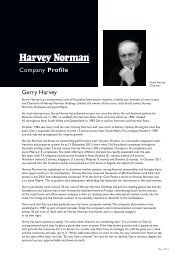annual report - Harvey Norman Company Reports & Announcements
annual report - Harvey Norman Company Reports & Announcements
annual report - Harvey Norman Company Reports & Announcements
Create successful ePaper yourself
Turn your PDF publications into a flip-book with our unique Google optimized e-Paper software.
CORPORATE GOVERNANCE STATEMENT (CONTINUED)<br />
including responsibility for the day to day design and implementation of the risk management and<br />
internal control system of the <strong>Company</strong>. Management <strong>report</strong>s to the board on the key risks of the<br />
<strong>Company</strong> and the extent to which it believes these risks are being adequately managed.<br />
Management is required by the board to carry out risk specific management activities in core<br />
areas, including strategic risk, operational risk, <strong>report</strong>ing risk and compliance risk. It is then required<br />
to assess risk management and associated internal compliance and control procedures and<br />
<strong>report</strong> back on the efficiency and effectiveness of these efforts by benchmarking performance in<br />
substantially accordance with Australian/New Zealand Standard for Risk Management (AS/NZS<br />
ISO 31000:2009 Risk Management).<br />
The board has a number of mechanisms in place to ensure that management‟s objectives and<br />
activities are aligned with the risks identified by the board. These include the following:<br />
(i) Board approval of strategic plans designed to meet stakeholders‟ needs and manage<br />
business risk.<br />
(ii) Implementation of board approved operating plans and budgets and board monitoring of<br />
progress against these budgets, including the establishment and monitoring of KPIs of both<br />
a financial and non-financial nature.<br />
As part of its duties, the internal audit function of the <strong>Company</strong> is responsible for the objective<br />
assessment of:<br />
(i) the systems of internal control;<br />
(ii) the risk and control framework; and<br />
(iii) generally, objective assessment of compliance by the <strong>Company</strong> with risk management<br />
protocols of the <strong>Company</strong>.<br />
In order to ensure the independence of the internal audit function, the head of internal audit<br />
meets privately with the audit committee without management present on a regular basis and is<br />
responsible for making the final decision on the head of internal audit‟s tenure.<br />
Underpinning these efforts is a comprehensive set of policies and procedures directed towards<br />
achieving the following objectives in relation to the requirements of Principle 7:<br />
(i) Effectiveness and efficiency in the use of the resources of the <strong>Company</strong><br />
(ii) Compliance with applicable laws and regulations<br />
(iii) Preparation of reliable published financial information<br />
CEO and CFO certification<br />
In accordance with section 295A of the Corporations Act, the chief executive officer and chief<br />
financial officer have provided a written statement to the board that:<br />
(i) Their view provided on the <strong>Company</strong>‟s financial <strong>report</strong> is founded on a sound system of risk<br />
management and internal compliance and control which implements the financial policies<br />
adopted by the board<br />
(ii) The <strong>Company</strong>‟s risk management and internal compliance and control system is operating<br />
effectively in all material respects<br />
The board agrees with the views of the ASX on this matter and notes that due to its nature, internal<br />
control assurance from the CEO and CFO can only be reasonable rather than absolute. This is<br />
due to such factors as the need for judgement, the use of testing on a sample basis, the inherent<br />
limitations in internal control and because much of the evidence available is persuasive rather<br />
than conclusive and therefore is not and cannot be designed to detect all weaknesses in control<br />
procedures.<br />
In response to this, internal control questions are required to be answered and completed by the<br />
key management personnel of all significant business units, including finance managers, in support<br />
of these written statements.<br />
Remuneration<br />
It is the <strong>Company</strong>‟s objective to provide maximum stakeholder benefit from the retention of a high<br />
quality board and executive team by remunerating directors and key executives fairly and<br />
appropriately with reference to relevant employment market conditions. To assist in achieving this<br />
objective, the remuneration committee links the nature and amount of executive directors‟ and<br />
officers‟ remuneration to the <strong>Company</strong>‟s financial and operational performance. The expected<br />
outcomes of the remuneration structure are:<br />
(i) Retention and motivation of key executives.<br />
(ii) Attraction of high quality management to the <strong>Company</strong>.<br />
(iii) Performance incentives that allow executives to share in the success of <strong>Harvey</strong> <strong>Norman</strong><br />
Holdings Limited.<br />
38<br />
ASX Listing Rule/<br />
Recommendation<br />
ASX Rec 8.2



